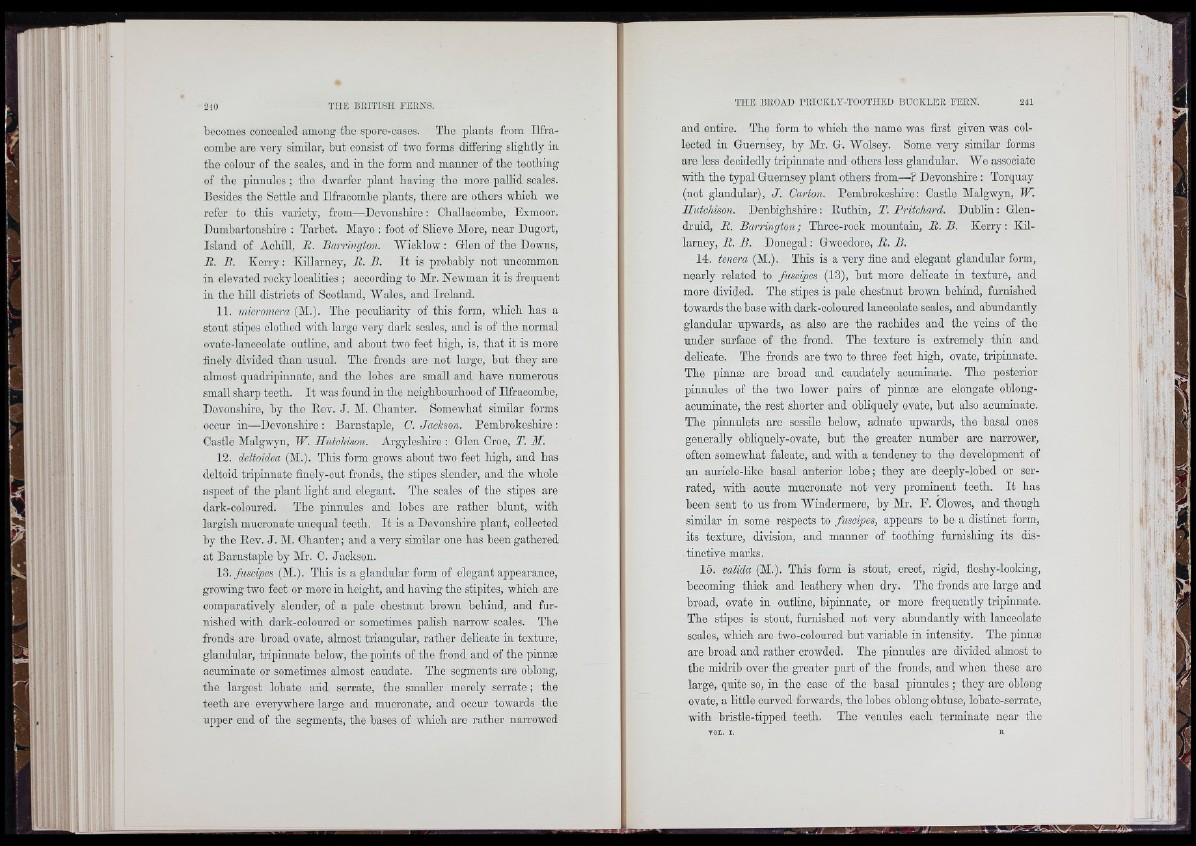
becomes concealed among tlio spore-cases. The plants from Ilfracombe
are very similar, but consist of two forms differing slightly in
the colour of the scales, and in the form and manner of the toothing
of tho pinnules ; the dwarfer plant having tho more pallid scales.
Besides the Settle and Ilfracombe plants, there are others which we
refer to this variety, from—Devonshire : Challacombe, Exmoor.
Dumbartonshire : Tarhet. Mayo : foot of Slieve Moro, near Dugort,
Island of Aohill, A. Barringfon. Wicldow : Glen of the Downs,
A. B. Kerry : Killarney, A. B. I t is probably not uncommon
in elevated rooky localities ; according to Mr. Newman it is frequent
in the hill districts of Scotland, Wales, and Ireland.
11. micromera (M.). The peculiarity of this form, which has a
stout stipes clothed with large very dark scales, and is of the normal
nvate-lanecolate outline, and about two feet high, is, that it is more
finely divided than usual. The fronds are not large, but they are
almost quadripinnato, and the lobes are small and have numerous
small sharp teoth. I t was found in the neighbourhood of Ilfracombe,
Devonshire, hy the Eev. J. M. Chanter. Somewhat similar forms
occur in—Devonshire : Barnstaple, G. Jackson. Pombrokeshiro :
Castle Malgwyn, W. Hutchison. Argylcshire : Glen Croe, T. M.
12. dettoidea (M.). This form grows about two feet high, and has
deltoid tripinnate finely-cut fronds, the stipes slender, and the whole
aspect of the plant light and elegant. The scales of the stipes are
dark-coloured. The pinnules and lobes are rather blunt, with
largish muoronate unequal teeth. I t is a Devonshire plant, collected
by the Eev. J. M. Chanter; and a very similar one has been gathered
at Barnstaple hy Mr. C. Jackson.
la.fuscipes (M,). This is a glandular form of elegant appearance,
growing two feet or more in height, and having tho stipites, which are
comparatively slender, of a pale chestnut brown behind, and furnished
with dark-coloured or sometimes palish narrow scales. The
fronds are broad ovate, almost triangular, rather delicate in texture,
glandular, tripinnate below, the points of the frond and of the pinnæ
aouminate or sometimes almost caudate. The segments are oblong,
the largest lobate arid serrate, the smaller merely serrate ; the
teeth are everywhere large and muoronate, and occur towards the
upper end of the segments, the bases of which are rather narrowed
and entire. The form to which the name was first given was collected
in Guernsey, hy Mr. G. Wolsey. Some very similar forms
are less decidedly tripinnate and others less glandular. Wc associate
with tho typal Guernsey plant others from—-P Devonshhe ; Torquay
(not glandular), J . Carton. Pembrokeshire ; Castle Malgwyn, W.
Hutchison. Denbighshire : Euthin, T. Pritchard. Dubhn : Glon-
druid, A. Barrington; Three-rook mountain, A. B. Kerry; Killarney,
A. B. Donegal : Gweedore, A. B.
14. teñera (M.). This is a very fine and elegant glandular form,
nearly related to fuseipes (13), but moro delicate in texture, and
more divided. The stipes is palo chestnut brown behind, furnished
towards the base with dark-oolom’cd lanceolate scales, and abundantly
glandular upwards, as also aro the raohides and the veins of the
under surface of the frond. The texture is extremely thin and
deboate. The fronds are two to three feet high, ovate, tripinnate.
The pinnæ are broad and caudately acuminate. The posterior
pinnules of the two lower pairs of pinnæ aro elongate ohlong-
aouminate, the rest shorter and obbquely ovate, but also acuminate.
The pinnulets are sessile below, adnate upwards, the basal ones
generaUy obliquely-ovate, hut the greater number are narrower,
often somewhat falcate, and with a tendency to the development of
an auricle-lffie basal anterior lobe; they are deeply-lobcd or serrated,
with acute muoronate not very prominent teeth. I t has
been sent to us from Windermere, by Mr. F. Clowes, and though
similar in some respects to fuseipes, appears to bo a distinct form,
its texture, division, and manner of toothing furnishing its distinctive
marks.
15. valida (M.). This form is stout, erect, rigid, fleshy-looking,
becoming thick and leathery when dry. The fronds are largo and
broad, ovate in outhne, bipinnate, or moro frequently tripinnate.
Tho stipes is stout, furnished not very abundantly with lanceolate
scales, which are two-colourod but variable in intensity. The pinnæ
are broad and rather crowded. The pinnules are divided almost to
the midrib over the greater part of the fronds, and when these are
large, quite so, in the case of the basal pmnules ; they are oblong
ovate, a httle curved forwards, the lobes oblong obtuse, lobate-serrate,
with bristle-tipped teeth. The venules each terminate near the
■ A. ;
i-i 14
' f c
i r : '
i l
'! A!
Í < “ i'
..i'll